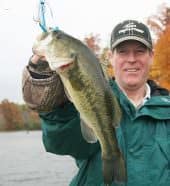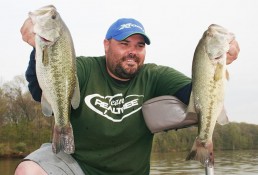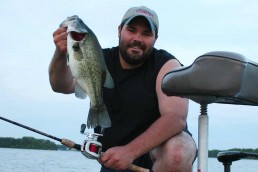Dirty Water Bassin’: Going for Big Bass When Visibility is Poor
SHARE THIS POST
Visibility is a significant factor in how we target bass. And water clarity changes throughout the year in tiny creeks, large rivers, small ponds, mid-sized natural lakes and massive reservoirs. During periods of high rainfall, creeks and rivers carry sediment downstream into the slower-moving sections of streams or into lakes and reservoirs, making clear water stained, and then into “chocolate milk”—this process can happen very fast, especially if rainfall is hard and fast.
At times, this can make the fishing difficult, and there are a number of factors to combat this situation. However, once fish adjust to these conditions and the anglers also adjust, this can result in “fast fishing,” with an even greater chance at landing a trophy.

When bass find themselves living in water that’s considerably dirtier than it was previously, they relax a bit knowing that predators can’t see them as easily. Additionally, the dirtier water can make it easier for bass to ambush their unsuspecting prey, like shad, bluegills, crawfish, or shiners that have limited visibility and don’t use vibration and sound as effectively as the predators chasing them can in these rapidly changing situations.
Location factors
Bass will often move into very shallow waters in muddy conditions. Bass love cover, regardless of the color of the water. They will stray farther from the cover in dirty water, but they’ll still use it to their advantage. Bass will hold in rocks, weeds, and wood, and they will also use man-made cover and hold under docks and around concrete bridge pilings or plastic fish attractors. But in muddy waters, bass can also be found in areas that are completely devoid of cover too, especially in the shallows. Large concentrations of big bass actively hunt flats, shelves, and shoreline banks with little to no cover, but this is far more likely in dirty water than in areas where there is good clarity. Clear-water predators rely upon cover more than those in heavily stained locations, but prey is a major key in finding active muddy-water bass. Find large schools of shad, shiners, or other kinds of baitfish, and active bass will be in those places hunting down a meal.
Presentation factors
Dirty-water gamefish don’t rely as much on sight as they do on other senses. The hearing of a bass, as well as its ability to pick up (feel) on vibrations made by prey moving through the water, are the two most critical senses they rely on to find prey in dirty conditions, and this tells us what kinds of lures and presentations to use. Once areas are found that hold lots of active bass, choosing lures that produce lots of vibration and sound is a major key.
Are you enjoying this post?
You can be among the first to get the latest info on where to go, what to use and how to use it!
Spinnerbaits, crankbaits, blade baits, and lipless cranks are top choices, as these types of lures produce plenty of sound and vibration. Larger blade baits are usually better than small versions. When selecting cranks for muddy water, it’s best to choose rattling models that produce more sound than non-rattling versions. Multi-blade spinnerbaits with Colorado blades or hatchet blades produce more vibration than willow leaf blades or Indianas do, as they displace more water as they turn, helping bass find them with greater ease when they can’t see as well. Soft plastics can be productive in dirty water, but the key is choosing larger plastics and ones that produce more vibration. A 10-inch, thick-bodied ripple-tail worm is a better bet than a 6-inch skinny, strait-tail worm. Freakbaits and big-claw ‘craws outproduce tubes in the mud. Adding rattles to these lures often makes them easier for bass to find.
Skirted bass jigs are bulkier than jig heads, displacing more water and creating more sound for dirty-water bass to home in on. Big, thick trailers, like freakbaits and the larger craw chunks with oversized claws, are the way to go in most muddy waters. Since these lures are typically fished on the bottom, when a slower presentation is required, it’s beneficial to use scent. Scents can be used on spinnerbaits, and can help in muddy water when fishing the lure very slow. However, while they can be used on crankbaits and blade baits, they’re less effective since they don’t stick well to the hard body of the lure. They do stick well to a spinnerbait skirt or trailer, though. It doesn’t hurt to use them on these lures, but it’s far more important with vertical lures and a slow presentation, like with jigs and plastics.
Get out there
To master the outdoors and the sports we pursue in the wild is immeasurable. Lots of big bass are taken each year in the dirtiest of waters, just like lots of big bass are taken each year in the clearest too. The real key to consistent, successful angling is being ready to switch gears at a moment’s notice and utilize any tactic that is needed to put fish in the boat when standard methods fail. That comes down to mastering every technique and building confidence in all of them so you can do them justice when you need them.
Together, with knowledge, the right kind of practice truly does make perfect. My staff guides and I thoroughly enjoy being able to spend so much time on the water. We just love teaching the methods we’ve used for so many years to successfully guide charter clients to once-in-a-lifetime trophies, win tournaments and championships, film national network TV shows, shoot photos for our international magazine articles and still make dates available for guided charters and lodging at our top destinations for the upcoming season. Just don’t wait too long.
Colby Simms is a professional fisherman, media personality, guide and owner of Colby Simms Outdoors Group. He runs a guide service, sells tackle and books on guided fishing and hunting trips. Contact: Facebook/ColbySimmsOutdoors/, email colbysimmsoutdoors@hotmail.com and call at 618-521-0526, 573-358-5948.
MWO
SHARE THIS POST
You may also like...
0 CommentsGreat Shallow-water Bass Action Right Now
Did you enjoy this post?
You can be among the first to get the latest info on where to go, what to use and how to use it!
Colby Simms
Colby Simms is a professional fisherman, media personality, guide and owner of Colby Simms Outdoors Group. He runs a guide service booking guided fishing and hunting trips, and sells tackle. Contact him at colbysimmsoutdoors@hotmail.com, Facebook @ColbySimmsOutdoors and @ColbySimmsSportFishingPro, or 618-521-0526 or 573-358-5948.


